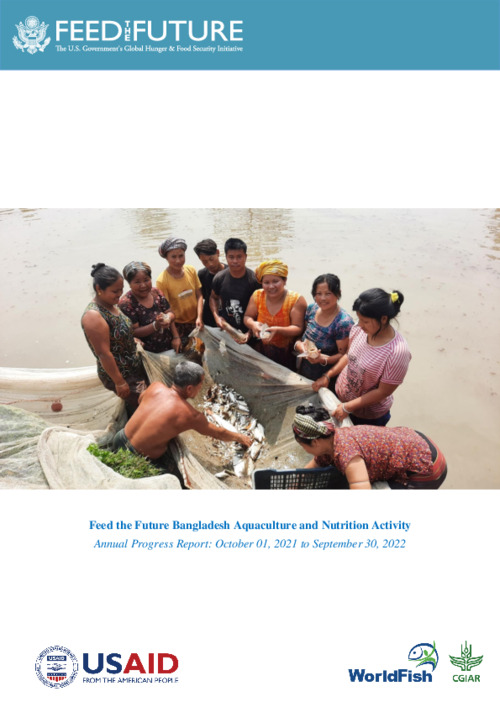USAID_Feed the Future Bangladesh Aquaculture and Nutrition Activity_Annual Progress Report: October 2021– September 2022

The Feed the Future Bangladesh Aquaculture and Nutrition Activity (Aquaculture Activity) is a USD 24.5 million, five-year assistance program, awarded to WorldFish on February 6, 2018, which is expected to continue until February 5, 2023. Aquaculture Activity aims to improve the livelihoods of at least 400,000 beneficiaries, including smallholder fish farmers and other actors in the aquaculture value chain. The interventions put emphasis on cross fertilizing knowledge, and sharing expertise so that the skills of the actors are developed, facilitating sustainable growth in the market. The Activity is being implemented by engaging partners from both private and public sectors located at 21 south-western districts and 2 south-eastern districts of Bangladesh, which are known as Feed the Future Zone of Influence (ZOI) and Zone of Resilience (ZOR), respectively.
The key outputs during the reporting period delivered in partnership with 50 partners and collaborative public sector include;
• Nearly 75% of the private sector partners’ revenue from their ongoing business has been increased as a result of the intervention piloted with of the Feed the Future Aquaculture and Nutrition Activity
• Aquaculture farmers and processors received around USD 1.95 million as loan from the Banks and NGOs who has promoted agency and micro retailer agent banking through tailoring small and delayed repayment schedules to match the seasonality of farmer/processor income
• The Activity has supported the development of recipes for Ready-to-Eat (RTE) and Ready-to-Cook (RTC) cultured fish products and their market promotion. A total of 20 metric tons of white fish in form of RTC and RTE items was processed and sold worth USD 329,633.
• The Activity partner has had significant success in promoting the production and marketing of natural pituitary gland (PG) , collected 3.03 kg PG from new fish cutters and PG collectors, sold 3.03 kg dry PG to 26 hatcheries and generated USD 196,000 revenue.
• Activity reached 384,570 people including 11.80% women and 12.81% youth up to year 5
• The Activity created access to 31,323 tons fish feed through newly established service points
• 7,567 Kg carp hatchlings and 216 million tilapia fries were produced worth of USD 2.56 million and sold to the 2,74,262 carp and 9,952 tilapia farmers
• Farmers applied improved management practices in total 89,497 ha area and produced 3,736 kg/ha carp and 6,525 kg/ha tilapia
• The farmers earned USD 440 million from their fish sales
As most of Aquaculture Activity’s work involves supporting more effective commercial interaction between the private sector and aquaculture farmers, it is likely that this might have and will be impacted by the continued challenges related to ongoing war in Ukraine which include higher commodity prices, and so the program will continue to closely engage with its partners to understand any need to re-focus activities in response to such pressures. For example, it may be pertinent to review training materials for farmers to support the use of less expensive locally produced feed rather than continuing to drive adoption of commercial products which may be becoming unaffordable in a market where consumer demand for fish will also be impacted by the same factors of price inflation. The Aquaculture Activity is continuing to leverage on its knowledge of the aquaculture value chain in order to respond where necessary to the effects of this conflict on Activity participants’ livelihoods.
Permalink
Date Available
Type
Countries
Copyright
CC-BY-4.0
Research Themes
Topics
Language